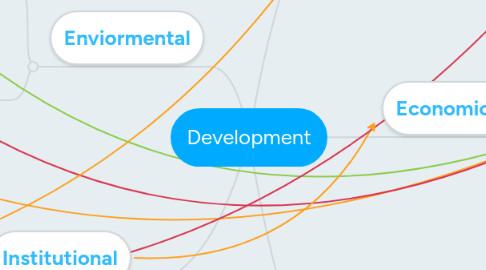
1. Enviormental
1.1. Resources
1.1.1. Countries can have vast amounts of materials; most could be traded or invested into their own projects.
1.1.1.1. Lack of materials would force countries to import from other states, reducing efficiency of development, yet could also pave the way for developing beneficial alternatives (e.g. sustainable green energy)
1.2. Climate Change
1.2.1. Major agricultural products could become impossible to produce
1.2.2. Resources and money must be spent in order to combat any major, possibly dangerous, environmental changes.
1.2.3. A definite incentive for affected countries to invest in green solutions
2. Institutional
2.1. IMF
2.1.1. Provide loans to any state to invest in projects
2.1.1.1. Loans will come with heavy interest rates, and sometimes with specific contracts
2.1.1.2. Small margins of time for payments can cause countries to fall in debt, wasting more money which could have been used for development.
2.2. World Bank
2.2.1. Loans, along with a larger span of time for payments, are given to poorer countries in order to invest in projects
2.2.1.1. A country's government is tasked to properly spend the money.
2.2.1.2. Can come with heavy restrictions and, arguably, imposes a country's sovereignty.
3. Political
3.1. Corruption
3.1.1. Money may be lost or invested inappropriately
3.2. Instability
3.2.1. Weak governance, due to civil war and the like, leave few opportunities to continue or even begin development
3.2.2. Divides between government and the populace can lead to long conflicts, discouraging investments or any possibility to focus on developments besides war.
4. Economics
4.1. Debt
4.1.1. Money is spent repaying others while projects no longer receive revenue
4.2. Trade
4.2.1. Developing countries are at an disadvantage due to the low prices of raw goods. This causes developed states to profit greatly with final products while developing states are trapped producing food and raw materials; their economy halted from ever developing further.
4.2.2. With various options from where one can buy raw materials, more labor can be invested into the production itself, instead of cultivating raw goods. Prices are then kept low for the final products, both for domestic and national sells.
4.2.2.1. Certain products are not beneficial, or even dangerous, to rely on from other countries, especially agriculture.
4.2.2.2. Interdependence for material and goods creates an environment where war results in fighting against one’s supplier and/or buyer. Furthermore the urge for war is decreased as dominance over an area will not be required to attain their resources.
4.2.3. Free trade causes neocolonialism, development through protectionism, and national security protectionism.
5. Social
5.1. Gender
5.1.1. Exclusion of one gender can negatively affect development due to the lack of input given to major decisions
5.1.1.1. Maternity matters without input from women often leads to higher risks of death or complications during process of carrying or labor.
5.1.2. Equal acknowledgement of women allows for an entire half of the population to respond and benefit projects
5.2. Culture
5.2.1. Ethnic divides create distractions for states
5.2.2. Certain cultures provide better opportunities in which people are not opposed to developments in society or their states.

